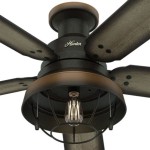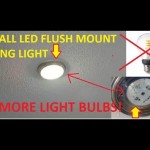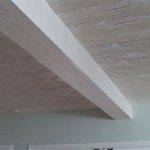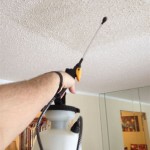Everything You Need to Know About Flush Mount Ceiling Lights
Flush mount ceiling lights are a popular and practical lighting solution for a variety of spaces. Characterized by their close proximity to the ceiling, these fixtures offer a streamlined appearance while providing ample illumination. Their low profile makes them particularly well-suited for rooms with low ceilings, where other types of light fixtures might feel intrusive or visually overwhelming. This article aims to provide a comprehensive overview of flush mount ceiling lights, covering their types, benefits, installation considerations, maintenance, and design aesthetics.
The selection of a flush mount ceiling light often depends on the room's purpose, size, and existing décor. They can range from simple, utilitarian designs to more decorative options featuring intricate detailing or unique materials. Understanding the various aspects of flush mount lights will aid in making an informed decision that best matches the intended application.
Types of Flush Mount Ceiling Lights
Flush mount ceiling lights are available in several distinct styles, each offering unique features and aesthetic appeals: standard flush mounts, semi-flush mounts, and decorative flush mounts.
Standard Flush Mounts: These lights are the most basic and common type. Their design is characterized by a housing that sits directly against the ceiling, offering minimal projection into the room. Standard flush mounts are ideal for spaces where functionality is prioritized over stylistic flair. Typically, they feature a simple diffuser, often made of glass or acrylic, which softens the light and prevents harsh glare. These lights are commonly found in hallways, closets, laundry rooms, and other utility areas where consistent and unobtrusive illumination is required.
The simplicity of standard flush mounts also makes them budget-friendly, making them an attractive option for large-scale installations, such as in apartment complexes or commercial buildings. Replacement of bulbs is usually straightforward, involving the removal of the diffuser and accessing the light source. The available light output will vary depending on the wattage and type of bulb used. LED options are increasingly popular due to their energy efficiency and long lifespan.
Semi-Flush Mounts: Semi-flush mount lights offer a compromise between standard flush mounts and pendant lights. They hang slightly below the ceiling, typically suspended by a short stem or rod. This slight distance from the ceiling allows for a more decorative design, incorporating elements such as metal frames, fabric shades, or intricate glass detailing. The added space between the fixture and the ceiling can also enhance light distribution, creating a softer and more ambient glow.
Semi-flush mounts are suitable for rooms where a touch of style is desired without sacrificing headroom. Living rooms, dining rooms, and bedrooms can benefit from the aesthetic appeal of semi-flush mounts. Installation is similar to standard flush mounts, but may require additional steps for securing the stem or rod. Ventilation is also improved compared to standard flush mounts due to the increased space. Bulb access can vary depending on the design, but generally involves removing the shade or diffuser.
Decorative Flush Mounts: Decorative flush mount ceiling lights prioritize aesthetic appeal. They come in a wide range of styles, materials, and finishes, allowing for the creation of a focal point within a room. These lights may feature elaborate designs, such as crystal embellishments, intricate metalwork, or unique geometric shapes. Decorative flush mounts often serve as both a source of light and a design element, contributing to the overall ambiance of a space.
Applications for decorative flush mounts include entryways, formal dining rooms, and bedrooms. The increased complexity of these fixtures may translate to a higher price point and more involved installation. Care should be taken to select a decorative flush mount that complements the existing décor and architectural style of the room. Cleaning and maintenance may also be more challenging due to the intricate details and delicate materials. Bulb replacement can be complicated depending on the fixture design and may require specific tools or techniques.
Advantages of Flush Mount Ceiling Lights
Flush mount ceiling lights present several advantages, making them a versatile lighting solution:
Space-Saving Design: One of the primary advantages of flush mount lights is their space-saving design. Because they sit close to the ceiling, they maximize headroom and prevent the feeling of a room being cramped. This is particularly important in rooms with low ceilings, where pendant lights or chandeliers may not be suitable. This low profile also minimizes the risk of accidental bumps or collisions, making them a safer option in high-traffic areas.
Even Light Distribution: Flush mount lights are designed to distribute light evenly throughout the room. The diffuser, often made of glass or acrylic, helps to soften the light and prevent harsh shadows. This can create a more comfortable and inviting atmosphere, especially in rooms where focused task lighting is not required. The wide dispersion of light also reduces the need for multiple light sources, simplifying the overall lighting design.
Versatile Style Options: Flush mount lights are available in a wide range of styles, from minimalist and modern to ornate and traditional. This versatility allows them to seamlessly integrate into various décor schemes. The availability of different finishes, materials, and shapes ensures that there is a flush mount light to suit any aesthetic preference. This flexibility makes them a popular choice for both residential and commercial applications.
Ease of Installation: Compared to other types of light fixtures, flush mount lights are generally easier to install. Most fixtures come with clear instructions and require basic wiring skills. The simplicity of the design also reduces the risk of installation errors. However, it is always recommended to consult with a qualified electrician if there are any doubts or concerns about the installation process. Electrical safety is paramount, and improper installation can lead to hazards.
Cost-Effective Lighting Solution: Flush mount lights are often a cost-effective lighting solution, both in terms of initial purchase price and long-term energy consumption. Standard flush mounts are typically more affordable than pendant lights or chandeliers, making them an attractive option for budget-conscious consumers. The use of energy-efficient LED bulbs can further reduce energy costs and extend the lifespan of the fixture. This combination of affordability and efficiency makes them a sustainable lighting choice.
Installation and Maintenance Considerations
Proper installation is crucial for the safe and effective operation of flush mount ceiling lights. Before commencing any electrical work, ensure that the power to the circuit is turned off at the breaker. It is recommended to use a voltage tester to confirm that the circuit is de-energized. Carefully read and follow the manufacturer's instructions for installation. Typically, this will involve connecting the wires from the fixture to the corresponding wires in the electrical box on the ceiling, securing the fixture to the box with screws or mounting hardware, and attaching the diffuser or shade.
If the existing electrical box is not compatible with the new fixture, it may need to be replaced. This should be done by a qualified electrician. Ensure that all wiring connections are secure and properly insulated to prevent electrical shorts or hazards. After installation, test the fixture to ensure that it is working correctly.
Maintenance of flush mount ceiling lights primarily involves regular cleaning to remove dust and debris. Use a soft cloth or duster to gently wipe the fixture and diffuser. For stubborn dirt or stains, a mild detergent and water solution can be used. Avoid using abrasive cleaners or solvents, as they can damage the finish or material of the fixture. Before cleaning, ensure that the power to the fixture is turned off. Regularly inspect the fixture for any signs of damage or wear, such as cracks, loose screws, or frayed wires. Replace any damaged components promptly to prevent potential hazards.
The lifespan of the light bulb will vary depending on the type of bulb used. LED bulbs typically last significantly longer than incandescent or halogen bulbs. When replacing a bulb, ensure that the new bulb is the correct wattage and type for the fixture. Over-wattage bulbs can generate excessive heat and damage the fixture or wiring. If the fixture is equipped with a dimmer switch, ensure that the bulb is compatible with dimming functionality. By following these maintenance guidelines, the lifespan and performance of flush mount ceiling lights can be maximized.
Ultimately, the selection of a flush mount ceiling light depends on a combination of factors, including the room's dimensions, the desired aesthetic, the available budget, and personal preferences. By carefully considering these aspects, it's possible to find the perfect flush mount light to enhance any space.

Everything You Need To Know About Semi Flush Mount And Lig

What Do You Need To Know About Flush Mount Lighting

The Most Popular Flush Mount Lighting Styles To Know

The Comprehensive Guide To Flush Mount Ceiling Lights

What Size Flush Mount Do I Need

What Is The Difference Between A Flush Mount And Semi Li

Recessed Vs Flush Downlights Which One Is Better For You Hirosart

Flush Mount And Semi Lighting Guide The Home Depot

60 Modern Flush Mounted Ceiling Light Designs Home Lighting Ideas Lights

In Focus Flush And Semi Mounted Lights 1000bulbs Blog
Related Posts








